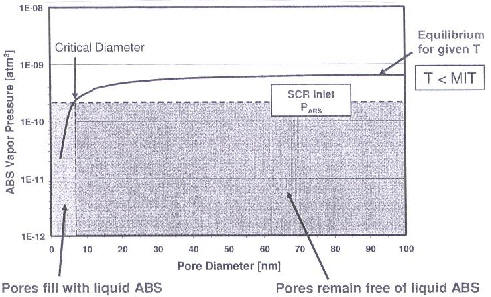
FGD
and DeNOx
NEWSLETTER
January 2007
No. 345
Cormetech Catalyst Can Be Used at Lower Temperatures for Limited Periods
Cormetechís design strategy for setting minimum operating temperature guidelines for SCR operation involves two distinct approaches: the Basic Approach, in which ammonium bisulfate (ABS) deposition on the catalyst is avoided, and the Enhanced Approach, which allows a controlled amount of ABS deposition and catalyst deactivation, before the ABS is driven off by heating above a recovery temperature. The Enhanced Approach provides significant opportunity to expand the SCR operating range below the temperature at which ABS first condenses in the catalyst, while maintaining the required NOx removal efficiency. Benefits to the utility include higher overall NOx removal, improved flexibility for load cycling and maintenance, and the potential for eliminating the need for an economizer bypass or alternate methods of temperature control for the SCR system in new designs and retrofits.
The Enhanced Approach requires a substantial understanding of the unitís operation (at full and part loads) and the catalystís response, including temperature (average and spatial distribution), gas composition: SO3, H2O, NH3 (DeNOx, inlet NOx, NH3 slip), gas flow rate, the expected ranges for these parameters (expected fuels), boiler transient information (temperature/flow versus time) and the routinely achievable temperature for recovery. Each plant must also consider the desired operating strategy (i.e., target load, temperature, hours, performance targets and frequency) that best enhances operability.
Figure 4 below presents a case where the temperature is now below the Minimum Injection Temperature (MIT) for NH3 for the SCR. ABS will form in pores smaller than critical diameter, while larger pores remain free of ABS and capable of performing the DeNOx reaction. (Note: Cormetech SCR CatalystTM has a tri-modal pore distribution with micro, meso, and macro power; the micro pores are most susceptible to capillary condensation effects).

Implementation of this strategy at TVA plants with Cormetech SCR catalyst provided significant cost savings due to lower permissible operating temperatures (net savings of about $2.4 million for the 2005 ozone season), without adverse effect on the catalyst, air preheater (APH) or stack opacity. See Figure 5. In addition to the cost savings, an additional 974 tons of NOx were reduced. Both benefits were accomplished with an implementation cost of $200,000. In addition, the new operating guidelines avoided the need to install an economizer by-pass on these units.
No adverse impact on stack opacity or APH operation was observed as a result of extended low load operation. Note that the APH temperature at Cumberland (CUF) was raised to 315oF to minimize SO3 condensation and APH plugging prior to the 2005 ozone season, Widows Creek (WCF) Unit 7 has an SO3 mitigation system upstream of the APH, and the WCF Unit 8 APH temperature was at or near the acid dew point temperature. (Note: that in Figure 5) BRF stands for Bull Run and KIF Kingston.)
Back to FGD and DeNOx Newsletter No. 345 Table of Contents